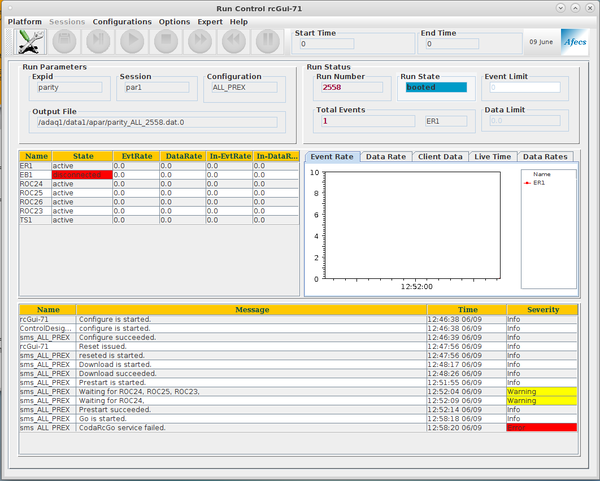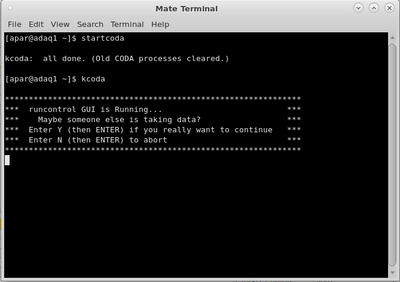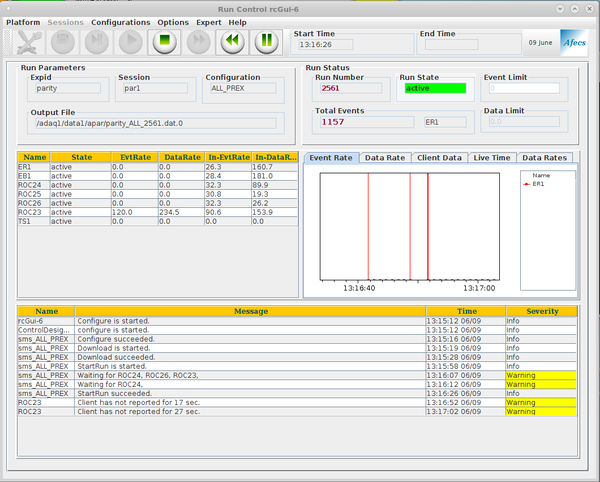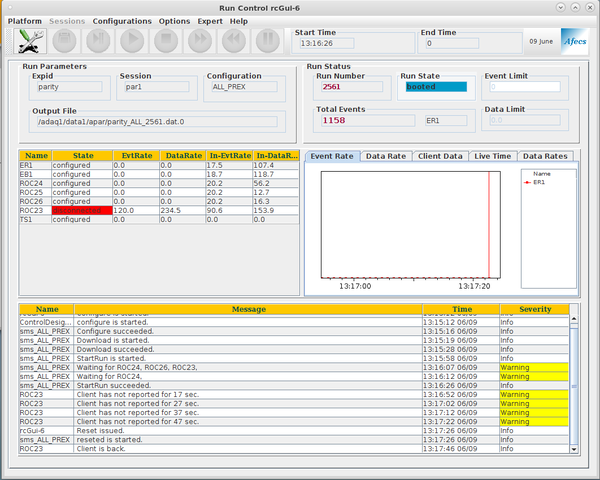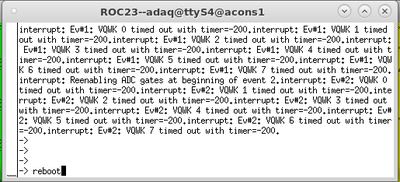Difference between revisions of "CODA"
From PREX Wiki
Jump to navigationJump to search| Line 74: | Line 74: | ||
** '''startcoda''' (follow instructions for [[CODA#Starting the GUI| starting CODA]]) | ** '''startcoda''' (follow instructions for [[CODA#Starting the GUI| starting CODA]]) | ||
* If a ROC is disconnected (see Figures 9 and 10) | * If a ROC is disconnected (see Figures 9 and 10) | ||
| − | *# try to reset; if successful you should get Client is back message and everything should report | + | *# try to reset; if successful you should get Client is back message and everything should report ''Configured'' |
*# if a ROC is still reporting a problem - note which ROC is reporting the problem | *# if a ROC is still reporting a problem - note which ROC is reporting the problem | ||
*## if the console for that ROC is responding type '''reboot''' and enter (see Figure 11) | *## if the console for that ROC is responding type '''reboot''' and enter (see Figure 11) | ||
Revision as of 14:27, 9 June 2019
Starting Parity DAQ CODA
Starting the GUI
- Log in as apar@adaq1
- In a terminal type startcoda
- 4 xterms will appear (red, orange, green and yellow) as well as the main CODA window (see Figure 1)
- CODA will automatically load the last configuration used. If you are ok with this then just go to Platform->Connect
- To change the configuration, choose Configurations->Cool
- Select the desired configuration from the dropdown list
- Production running would be ALL_PREX
- Once you have loaded a configuration, some of the icons (see descriptions below) will change from grey (see Figure 2) to green (Figures 3-5)
- Press the configure icon (see Figure 3)
- Warnings about waiting for a ROC can be ignored if it does not take too long to respond (~10s) and things are eventually successful
- Error messages should be taken seriously
- You can try a Reset and re-Configure
- If that doesn't work - see DAQ Troubleshooting
- Press the Download icon (see Figure 4)
Starting a run
- After starting the GUI and loading a configuration (see above)
- Press the Prestart icon (see Figure 4)
- a window will pop up where you can add notes if necessary (not yet implemented for PREX)
- submit or save the notes if applicable
- As above, warnings about waiting for a ROC can be ignored (if it does not take too long to respond, ~10s) and things are eventually successful
- Error messages should be taken seriously!
- You can try a Reset and re-Configure
- If that doesn't work - see DAQ Troubleshooting
- Press Go (see Figure 5)
- the event counter should start incrementing (see Figure 6)
- the event rates should be expected values
Ending a run
- Press End
- if this was a normal end of the run, and it ends successfully
- all the states should change to downloaded
- the Prestart icon should be green
- if this was a normal end of the run, and it ends successfully
- If the run ends because of a problem with CODA - see DAQ Troubleshooting
Description of the GUI
Numbered from the top left of the GUI window (see any of the Figures):
- Configure (tools) - this opens a drop-down menu to choose the configuration
- Download (floppy disk) - this loads the chosen configuration to the crates
- Prestart () - this will prepare to start a run
- Go (triangle with point to right) - this starts a run
- End (square) - this ends a run
- Fast Start (double-triangle pointing right) tries to go through all the steps (can be used as long as things aren't changing)
- Reset (double-triangle pointing left) configured, but not downloaded (if you need to change configuration or GUI is wonky)
- Pause (two vertical bars) - pauses a run (rarely used - to quote Paul King "Nothing good can come of this.")
DAQ Troubleshooting
- Either the Event Builder (EB1) or Event Recorder (ER1) are disconnected (see Figure 7)
- type kcoda in a terminal, say Y(see Figure 8)
- startcoda (follow instructions for starting CODA)
- If a ROC is disconnected (see Figures 9 and 10)
- try to reset; if successful you should get Client is back message and everything should report Configured
- if a ROC is still reporting a problem - note which ROC is reporting the problem
- if the console for that ROC is responding type reboot and enter (see Figure 11)
- otherwise, use the remote power cycle to reboot that ROC (link to be added later)
Instructions for shift checklist
- Latest run type (Test, Physics,..)
- Is the auto replay script running (ask the analysis expert)?
- Is the PREX run list (in a white binder) completed? (are we going to do this?)
- Please attach the left/right HV and Scalers Screenshots to the shift report
- Time of beginning of latest run (RHRS)
- Latest run number
- Dead time (%)





